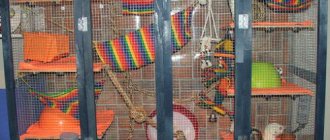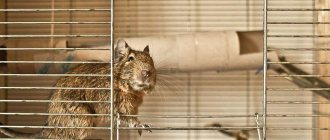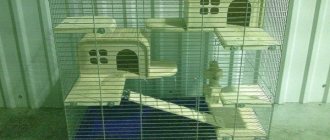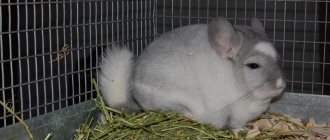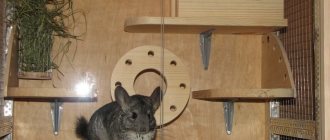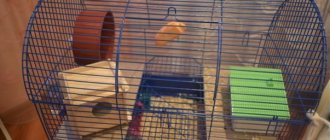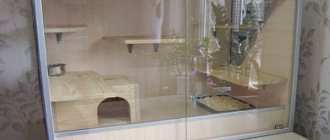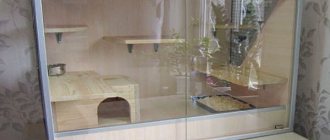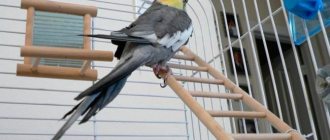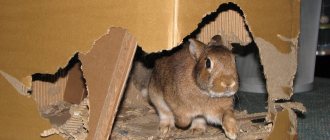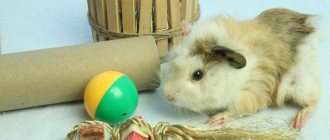Rabbits are not only fluffy fur, but also three to four kilograms of dietary and easily digestible meat. Who doesn’t remember this joke by the famous comedian duo? But there is some truth in it. It is indeed very profitable to breed this animal at home. But where should they live so that the furry creatures do not die in the summer under the scorching sun or in the winter in conditions of extreme temperature drops?
For this purpose, houses are ordered or rabbit cages are created with your own hands. The last option seems preferable, so let’s consider it in more detail.
Even custom ordering rabbit houses may not be a good idea. Often the design breaks down quickly or is inconvenient for rabbits to live in and is made from toxic materials. Therefore, you have to think about how to make a cage for rabbits with your own hands, since this is not an expensive and practical way to solve the problem.
Types of cages for rabbits
Rabbit cages are classified according to the following criteria:
- Type of rabbits. Large and small breeds, adults, pregnant females and those who have recently given birth, young animals kept for separate living.
- Method of operation. Stationary, portable. Outdoors, indoors.
- Material. Wood, metal, plastic.
In one household it is permissible to have several different types of cages for rabbits, each of which serves its purpose. According to their design, cells are divided into single-tier, two-tier, and three-tier. The choice depends on the available space. Despite the differences in designs and parameters, there are general manufacturing rules that have been proven in practice. It is recommended to adhere to them.
Sheds
So, now you know what size rabbit cages should be. Drawings of such structures are presented on this page. Now let's see where to place the finished cells. Of course, you can put them right on the street. In this case, tiers are usually placed under trees. With this arrangement, in summer the animals will be protected from direct sunlight, and in winter - from the piercing wind. However, it is better to install cages in special sheds. This is the name for structures with a gable roof, the side walls of which are formed by the rear walls of the tiers. That is, the cells are installed in two rows with the facades facing the inside of the resulting room.
Shed doors are made with swing doors. They are often double. In this case, in addition to solid panels, a mesh door is installed. In summer, the wooden doors open. The screen door remains closed. As a result, the animals receive more light and fresh air. On the south side there is usually an enclosure for walking young animals.
DIY rabbit cage construction
The creation of structures begins with the selection of materials. The basis is wooden blocks treated with antiseptics to avoid damage to the wood. In addition to the frame, you should take care of the walls, floor, ceiling, and doors. For individual parts of the structure, appropriate material is selected.
To build a rabbit cage you will need:
- bars;
- boards;
- plywood;
- net;
- wooden slats;
- metal wire;
- slate;
- plastic pallets;
- door bolts;
- loops;
- fasteners;
- drinking bottles.
Internal partitions are made from sheets of plywood, using its qualities such as strength and moisture resistance. Chipboard is an unsuitable material because it absorbs moisture and breaks down due to swelling.
Before installation, the wooden parts are sanded and sanded. Do not leave sharp edges so that animals do not get hurt on them. It is advisable to cover the protruding parts with iron. The height of the legs depends on the location: when installed outdoors, their size is from 80 cm, and indoors they are half as low. The diameter of the cells should be no more than 2x2 cm. When installing rabbit cages in an open space, the use of roofing materials is necessary. It is undesirable to make the roof metal, since its strong heating in hot weather can lead to thermal shock.
Necessary materials
It is recommended to make cages for rabbits from lumber, as well as combined building materials, the creation of which uses a minimum amount of adhesive and synthetic components.
To make cages for breeding, young and adult rabbits, you will need the following material:
- edged board - size 30x100x3000 or 30x150x300 mm. Necessary for lining the side and back walls of the cage. Can be used for lining a portable queen cell;
- wooden blocks - 40x40x3000 or 50x50x3000 mm in size. Will be needed to make the frame, legs and other elements of the cage. If desired, you can use rectangular bars;
To assemble the cage frame, an edged block with a section of 40×40 or 50×50 is used
- moisture-resistant plywood - 9 or 12 mm thick. It will be required when making a cage floor, wall cladding and other solid elements. It is better to use sheets measuring 150x3000 mm;
- steel pipes - with a cross section of 20 mm. They are rarely used, but if you know how to work with a welding machine, they allow you to assemble a strong and durable frame. It is not recommended to use for assembling the floor and making other elements that will come into contact with the body of animals ;
- steel mesh - galvanized fine mesh with a cell size of 15x15 or 20x20 mm. Necessary for making doors, covering some walls and re-upholstering the waste disposal area;
To cover the walls and doors in a cage, it is better to use galvanized mesh with a cell of 20×20 mm
- galvanized sheet - with a zinc coating with a thickness of 120 microns. It will be required in the manufacture of roofing, floor cladding and other elements for some types of cells. It is better not to use it for cladding the roof of outdoor cages;
- corrugated slate is a traditional roofing material. It is better to use old slate to cover the roof of street cages, which will significantly reduce the overall cost of the structure.
To assemble the cage frame, galvanized self-tapping screws 70 mm long are used. The boards and plywood are fastened using self-tapping screws 30–50 mm long. If desired, galvanized nails of appropriate length can be used. Doors, feeders and other rotating elements are fastened to ordinary furniture or door hinges.
Stages of building a rabbit cage
The production of cages for rabbits occurs in stages. First, the prepared bars are treated with an antiseptic. This prevents the appearance of rot on the tree and the penetration of harmful microorganisms. The requirements for the antiseptic are environmental friendliness, the absence of a large amount of chlorine, so as not to expose pets to harmful chemicals. This treatment increases the service life of wooden products.
The processed timber is cut into parts: four one and a half meters long, four 55 cm each, two 70 cm each. Then the planks are connected in such a way that two identical rectangular figures with sides of 1.5 and 0.55 m are obtained. After connecting with the beams, a box is obtained , which is the basis of the cage for keeping rabbits. Dimensions may vary depending on design.
Then you should start building the floor. It can be made from different materials, which have their own advantages and disadvantages: metal profiles, mesh, slats. A high-quality floor will be obtained by combining. For example, there is a metal profile below, and a mesh on top. The profile will prevent the mesh from deforming, which increases service life. Such a floor is not subject to rotting, like wood, but it faces another danger - metal corrosion. In addition, a metal floor is cold for rabbits to live in, while a wooden floor creates a more natural environment for them.
Expert opinion
Dobryshev Sergey Anatolievich
Professional rabbit breeder and hare breeder with 30 years of experience
If you intend to place a queen cell for grown-up rabbits in a cage with female rabbits, a part 50-70 cm wide should be left on the floor with a mesh for the construction of a wooden covering. The floor is secured with nails and screws.
Material for walls - boards, plywood, mesh. The back part is made of boards. For the front, a mesh is used. This allows you to observe the behavior of your pets. Plywood is suitable for the side parts. The roof is also made of waterproof plywood, but if the design provides for its tilting, then it is necessary to attach hinges. They are screwed to the timber, and then the plywood is installed. The entire structure is placed on legs about a meter high. The last stage is the installation of feeders and drinkers.
Animal conditions
These rodents are unpretentious in nature, quite mobile, and live in ordinary earthen burrows. However, for both dwarf domestic and industrial (meat, skin) breeds, excessive mobility is not needed, so the cages are made with serious space restrictions.
Modern French rabbit farm
Traditional rabbitry in Spain
Before choosing a specific product, or rather, the size of the future homemade product, you need to consider:
- pet size. Dwarf breeds weigh about a kilogram (or less), the largest (White Giant, German Giant, Giant Ram) weigh 12 kilograms or more. The dimensions of their body, respectively, are from 10...12 to 70 cm. The rabbit must fit freely in the cage, be able to turn around in it, and move in small leaps. That is, the minimum width should be equal to the length of the body, and the length should be no less than three to four times the length of the body. It is believed that for an average-sized rabbit the area should be at least 0.2...0.3 square meters for young animals and approximately 0.5...1 sq.m. for an adult animal;
- the number of pets in the cage and their age. For queens with babies, less space is required than for fattened young animals, but in any case, the minimum cage sizes are determined by the largest of the animals;
- type of content – cellular, semi-free, free. Considering that the article is about cells, we are considering cellular maintenance - it reduces the risk of uncontrolled reproduction, degeneration due to inbreeding, disease and death of animals;
- method of keeping - outdoors, under a canopy, indoors, combined;
Two-tier cages for keeping in a ventilated barn. Please note that for meat breeds the cage sizes are smaller!
- arrangement of cages - separately for each animal, with grouping - a row, several tiers, the so-called shed, that is, a group of cages under a common canopy;
- availability and cost of building materials.
To keep decorative breeds, cages are often purchased or made from scrap materials. To keep meat-hide and downy breeds, products are assembled in batches for the entire population of rabbits, taking into account the increase in quantity. It is advisable to breed downy and valuable fur breeds under a canopy to preserve the quality of the skin.
Instructions for building a rabbit cage yourself
The construction of a rabbit cage begins with a drawing. The optimal options are selected depending on the breed, age, and number of animals raised. The choice of materials depends on the following criteria: strength, resistance to mechanical stress, resistance to moisture.
We should not forget that rabbits belong to the order of rodents and can significantly damage wood. The materials used must not evaporate harmful substances. Drafts are unacceptable, but there must be air circulation, which is provided by micropores in the walls. All fittings used must be of high quality and protected against corrosion.
Construction begins with the construction of a frame to which a metal mesh and sheets of plywood for the walls are attached. Arrangement of the floor is a crucial moment. The best option is replaceable structures. They are easy to remove, clean and reinstall. In case of severe damage, they can be replaced with new ones. Metal mesh is more convenient to clean, but it provokes dermatitis, so wooden slats are preferable.
The roof of the rabbit cage is also a canopy that protects from precipitation and ultraviolet rays. You can make additional opening doors in it. The roof has a slight slope. In addition to plywood, roofing materials can include tiles and slate. The metal option is not suitable, since in hot weather this will lead to strong heating inside.
The finished cage is installed outdoors or indoors, depending on weather conditions. In cold weather, insulation is carried out by upholstering the cell walls with sealants: mineral wool, polystyrene foam, stitched mats. Rabbit hutches require regular maintenance.
Aviaries
Animals can also be kept in enclosures. The main advantage of these structures is that rabbits in the enclosure live almost the same way as in nature. Here are the main features of the enclosures:
- Animals have a lot of free space;
- There is no need for automatic feeders;
- Rabbit droppings mixed with grass and soil provide additional insulation;
- You can clean the enclosure no more often than once a quarter.
Aviary for rabbits
An aviary is, in fact, not even a cage, but just a place fenced with a chain-link mesh. But, despite its many advantages, the enclosure also has a serious drawback: in enclosure conditions, animals can quickly become infected with dangerous infections from each other. However, many farmers consider an enclosure to be the most convenient home for furry animals. In order to make an enclosure, it is not necessary to search the Internet for drawings and diagrams; it is enough to drive pegs around the perimeter of the area and cover the area where the animals are kept with a strong mesh with small cells. But still, sheds for rabbits are better than enclosures, especially in regions with cold climates.
DIY rabbit cages: drawings, dimensions
When doing serious business, one cell is not enough. A whole complex of structures will be required, for each of which a separate drawing must be drawn up. The appearance of cages for rabbits largely depends on imagination and financial capabilities, but there are size limits that are not recommended to be violated. The height of the room should not be less than 45 cm. For adults, the optimal area is 150x70 cm. It is necessary to provide a place where the animals can walk.
The front wall is made a few centimeters higher than the back. Individual sections can be connected by small manholes. The hinged lid will provide additional convenience during maintenance. Regardless of the breed being raised, we must not forget that the animals must have sufficient space for movement. Their deficiency will lead to obesity and decreased fertility. In outdoor cages you can make holes into a fenced pen.
You can get ideas for rabbit cages by browsing the relevant websites. If you want to draw up your own drawing, you can do this on graph paper or by using special programs and printing the result.
Why is the popularity of rabbit farming declining?
There are several reasons for this phenomenon, the most important ones should be mentioned.
- Increasing the well-being of our compatriots. You need to understand that previously, rabbits were bred in villages or dachas not out of great love for animal husbandry, but in order to improve the standard of living. Rabbit farmers, in addition to meat, brought income from skins, from which winter hats, fur coats, etc. were massively sewn. Today no one wears such hats, so handing over skins is a big problem. Currently, young people prefer to buy meat in a store rather than breed animals themselves.
Breeding rabbits requires not only knowledge, but also a lot of work
- Rabbit breeding is one of the most risky activities; in the event of an epidemic, the entire livestock dies within a day.
Meat is unsuitable for consumption and must be disposed of at special landfills. A veterinarian must live nearby, carry out periodic inspections of the livestock in a timely manner and carry out all vaccinations. If there is a veterinary hospital only in the regional center, then it is better not to breed rabbits. Rabbits are too susceptible to disease
We will not list other factors hindering the massive development of rabbit breeding, but there are quite a few of them. But even those mentioned should force potential rabbit breeders to carefully weigh their options against practical conditions.
Rabbit cage sizes
Drawings of cages for rabbits with dimensions: examples
The most common are double structures with separate sections. One section houses the adults, and the other contains the queen cell. Other types include cells with one section, three sections, and group ones. There are original designs.
Drawing up a drawing, algorithm of actions
First you need to draw up a drawing in one plane. It will become clear how much space the structure will take up, and if necessary, make adjustments.
An axonometric drawing will make the future home more visual.
Do-it-yourself rabbit cage: photo examples, types of designs
There are significant differences between rabbit hutches. If you want to make it yourself, you can choose from existing designs.
Simple one-story
Two-story
With a place to walk
Made of wood with metal mesh
Cage for adult rabbits
For adults, two-tier and three-tier cages are suitable. This significantly saves the area allocated for rabbit breeding. Plywood partitions divide the interior into areas for eating and relaxing.
The family home consists of three sections. A breeding male with good characteristics is placed in the middle, and healthy females suitable for mating are placed in the side compartments. Manholes are made between the compartments.
The construction of three-section cells has its own peculiarities. The frame is assembled from timber, and boards are used on the outside. On the inside, plywood is preferred. The back wall is made of boards, and a mesh is mounted in front. The compartments for females have an attic where she can climb using a special board. This is necessary for the rabbits to rest from maternal duties. Otherwise, they may develop aggression, leading to the death of newborns. This option is suitable for breeding purebred rodents, allowing you to sort individuals and monitor the onset and progress of pregnancy.
A separate room for young animals is built with minimal dimensions. You can immediately move strong rabbits into a room for adults.
Do-it-yourself rabbit cage: step-by-step instructions for the production of work with photo examples
DIY rabbit hutches have the great advantage of allowing you to take your specific circumstances into account. For example, we can consider the construction of a two-section cage.
Step 1. Treat the bars with an antiseptic.
Step 2. Cut the timber into parts of the required size in accordance with the requirements of the drawing.
Step 3. Connect the parts so that you get rectangular shapes.
Step 4. Assemble a frame from them.
Step 5. Start installing the floor.
Step 6. Start upholstering the walls. The back one is made of boards treated with an antiseptic, and the front one is made of mesh.
Step 7. Cover the inside of the walls with plywood.
Step 8. Build the roof.
Step 9. Install planks on which movement is possible.
Step 10. Place an excrement tray at the bottom.
Step 11. Place the cage on supports.
Step 12. Place feeders and drinkers inside.
Standard double option
In addition to multi-tiered ones, long cages are often used in private households. A couple of animals are placed in them at once. Dimensions of cages for double rabbits:
- in length - 210-240 cm;
- width – 65 cm;
- in height from the facade - 50-60 cm;
- height from the rear wall – 35 cm.
Queen cells are located on the sides of such cells. The remaining part houses the aft compartments. The floor in them is made of lattice, and in the nesting compartments it is solid. In the middle of the cage there are mangers made of V-shaped mesh, designed for distributing roughage. Drinkers and feeders for grain are hung on the doors.
Do-it-yourself two- or three-tier cage for rabbits: step-by-step instructions with photo examples
To make a rabbit cage you will need some materials. The frame is made of timber, the ribs of which are located inside, sheathed with a metal corner to protect the wood from the sharp teeth of rodents.
Assemble the sides. The parts are fastened with corners using self-tapping screws.
From the edge, measure the distance corresponding to the door, and attach the partition to give strength. The same actions are repeated on the opposite side.
Between the door openings, 2 bars are mounted in the shape of the Latin letter “V”. This is where the feeder will be located.
Having assembled two such partitions, they are connected with pieces of bars using reinforced corners. The result is a finished frame.
Now it's time to start installing the bottom. A good option is to use wooden slats.
The gaps between them should be of such a size that the rabbit's paw cannot get stuck there.
The protruding parts must be cut off.
Cover the first tier with a sheet of metal and fix the stop for installing the second floor.
The third tier is also installed.
Now it's time to install the doors. Loops are used for this.
Before moving in it is necessary to carry out disinfection.
Cages for rabbits in two tiers
The construction of a two-tier cage is not much different from a single-tier one. The height is 2-2.5 m, width – 1.4 m. The dimensions can be changed, but within small limits.
How to make a two-tier rabbit cage with your own hands: nuances
When designing, it is necessary to provide for nuances that will make the premises reliable and make caring for animals easier:
- It is recommended to use hinged doors in the rear wall or roof.
- Don't skimp on fasteners.
- To prevent rabbits from injuring themselves, the edges of the mesh and fasteners should be carefully sealed.
- Installing a retractable tray will make cleaning easier, where feces will fall through the mesh on the floor and urine will flow.
- The lock, which is a piece of wood rotating on a nail, is unreliable. A better option is hooks or latches.
- To prevent rabbits from gnawing the partition, the edges of the openings should be lined with tin.
- The roofs of each of the tiers can be lined with linoleum.
What you need to know
The required dimensions of cages for fattening rabbits, keeping queens and breeding rabbits during production must be observed. If you put a large animal in a small “room”, nothing good will come of it. Deprived of the opportunity to move freely, the animal will develop poorly. The discomfort in the cages also affects the rabbits' ability to reproduce. In addition, when there is a lot of crowding, the risk of various types of infectious diseases increases.
As you can see, making cages and even a shed for rabbits yourself is not at all difficult. Comfortable homes for these animals have a fairly simple design. The optimal size of cages for rabbits depends only on the body constitution of that particular breed.
Keeping and breeding pets requires knowledge and compliance with certain norms and rules. The most important thing is the maximum imitation of the conditions in which animals live in the wild. Rabbits are known for their unpretentiousness in matters of nutrition, maintenance, and resistance to most diseases.
However, the cage should be selected with special care, based on the number of individuals, their age and sex composition.
Making your own rabbit cage using the Mikhailov method
Rabbit cages built using the Mikhailov method are multi-tiered mini-farms. The structure consists of several tiers, each of which serves as the basis for the next. The bottom is made of slatted lattice, which ensures that manure falls into a special container. The walking compartment is equipped with feeders and drinking bowls. Food and water are replenished as needed.
The main advantage of mini-farms is minimal human participation in the production process, which ensures the absence of stress for shy animals.
Cages for rabbits Zolotukhina
This structure increases the efficiency of raising rabbits. The structure consists of three tiers. The higher ones are shifted relative to the lower ones by the width of the grid. There are two cells on each floor. The feeder is a tilting tray, which makes it possible to add food without opening the door.
This design is very popular.
Rating of premium quality designs
Ferplast Krolik 200
This is a large structure whose dimensions allow you to contain two animals at once. The main feature is that the pallet, like the metal gratings, can be completely disassembled. It is sold in compact packaging, which makes transportation much easier. Once assembled, it is a spacious home that is very easy to clean. The model has small doors. The kit also includes all the necessary accessories: a bowl, a drinking bowl, a feeder and a plastic house. The structure is easy to assemble and disassemble thanks to the latches. Another advantage of the model is the presence of a partition, which allows you to isolate the animal. The grille material is resistant to your pet’s teeth, as it is made of metal rod and coated with protective paint. Average price: 10,526 rubles.
cage Ferplast Krolik 200
Advantages:
- Large space for the animal to move;
- Accessories included;
- Sold in two colors;
- You can purchase an additional module separately;
- Convenient front door for quick cleaning;
- High assembly reliability.
- Easy to install.
Flaws:
- High price.
Ferplast Ranch 100 Basik for outdoor use
The mini farm comes with all the amenities your rabbit needs. It can be used both outside and inside the house. The main advantage is the strength and durability of the model. The main manufacturing material is northern pine wood, which is delivered from forests specially designated for these forests. It is protected by a water-repellent, mildew- and UV-resistant coating that is safe for humans. To increase the service life of a wooden structure, the boards must be carefully adjusted and connected with screws. The cage is two-level and divided into several zones, which are designed to meet the needs of the pet throughout the day.
The lower level is an area enclosed by a metal grill, and the door can be moved. There is also a safe door that leads upstairs. The top floor is a tranquil place to relax with a deep wooden base and a pull-out tray, and there is also a rest house decorated with beautiful designs on the outside.
There will also be no problems with care. The model is equipped with a hinged lid that allows for quick cleaning. Today the cage is sold in two colors. Average price: 15,200 rubles.
Ferplast Ranch 100 Basik outdoor cage
Advantages:
- There are all the amenities for a rabbit;
- A special coating will ensure a long service life of the product;
- Suitable for outdoor and home use.
Flaws:
- Not detected.
Cages for dwarf rabbits: step-by-step instructions
Cages for dwarf rabbits do not require large material costs. The weight of a dwarf rabbit is small, so the house for it should be appropriate.
Step 1. Assemble a frame 1 m long, 70 cm wide, 55-70 cm high.
Step 2. Nail wooden slats to the bottom or install a metal mesh.
Step 3. Make the walls. Cut a hole in one of them for the door.
Step 4. Place the door on the hinges.
Cages for giant rabbits
Rabbit cages for the “giant” breed are larger than usual. Adults reach a length of 60 cm and a weight of 7.5 kg. The minimum area per animal should be 0.3-0.5 m2. The height of the house is from 55 cm.
Feeders, drinkers and hay
It is important not only to have an idea of how to build a rabbit cage, but also how to properly equip it from the inside. Feeder, drinkers and hay are the constant attributes that must be present.
When equipping a drinking bowl, it is important to take into account the fact that it can be easily removed, since it will have to be washed frequently and the water in it changed. It is best to use trays made of metal strip for this purpose. Attach them to the cage door or next to it on the wall.
One of the most optimal options for making a drinking bowl is using sewer pipes. A scrap of this material with a diameter of 10 cm and a height of 8-10 cm is used to decorate the “cup holder”. A trimmed 2-liter plastic bottle fits into this ring. Cut it so that it is on the same level as the “cup holder”, leaving only a strip 2-3 cm wide and 5-7 cm long.
How to build a cage for a decorative rabbit with your own hands
When designing cages for decorative rabbits, you should provide for free movement in them. It is recommended to build two tiers with the possibility of transition. You need to start by drawing up a drawing, since such cages are often installed directly in the apartment. In a two-story cage, you should make two doors: one at the bottom end, and the second at the top.
DIY rabbit cages - photo
You can choose a suitable design or borrow an interesting idea by considering the available options.
